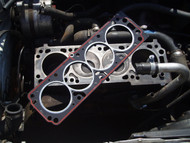What Is a Blown Head Gasket?
19th Sep 2018

What's a Blown Head Gasket?
A blown head gasket is an all-too-common problem experienced by drivers. Even with low-mileage vehicles, the head gasket may blow, thereby increasing the risk of serious and potentially catastrophic engine damage. Unless you're familiar with the automotive mechanics, though, you might be wondering what is a blown head gasket.
Head Gaskets Explained
To better understand a blown head gasket, you must first familiarize yourself with the head gasket itself. In the past, vehicles were typically designed with a combination engine block and cylinder head. Modern vehicles, however, feature a cylinder head atop the engine block. By separating these two components, the failure one component won't necessarily cause the other component to fail. The problem is that the space between the cylinder head and engine block may leak, causing exhaust gasses, coolant and/or oil to leak.
A head gasket is a thin, pre-cut sheet of metal with holes for the cylinders and fluid passages. It's primary purpose is to create an airtight seal between the cylinder head and underlying engine block. But like all gaskets, it may leak and no serve its intended purpose. A leaky head gasket is most commonly known as a blown head gasket.
What Happens When a Head Gasket Leaks?
A blown head gasket can cause a variety of problems. As the head gasket leaks, either exhaust gasses, coolant or engine oil may leak into area where they shouldn't. Depending on where the leak is located, exhaust gasses may leak into the vehicle's cooling system, coolant may leak into the cylinders, oil may leak into the cooling system, or coolant may leak into the oil.
Repairing a Blown Head Gasket
A blown head gasket typically isn't "repaired." Rather, it's replaced with a new head gasket (along with new head bolts). While head gaskets themselves are relatively inexpensive -- usually around $75 to $200 -- it's the labor that's the biggest expense of replacing a blown head gasket. It can take an automotive mechanic several days to replace it. And considering that mechanics charge by the hour, this makes it a pricey service.
Of course, you can replace a blown head gasket yourself if you have the right tools. Among other things, this includes a torque wrench, jack, jack stands, socket wrench with extension and a Haynes Manual for your make and model vehicle. Be warned, however, as replacing a blown head gasket is a time-consuming and laborious process.




